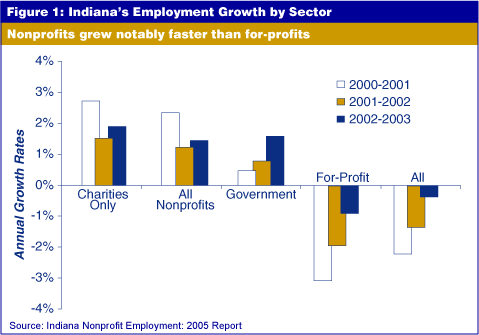The Economic Impact of Indiana's Nonprofits
Nonprofit organizations make significant contributions to the quality of life for Indiana citizens and are also a major force in the state’s economy.
A new report presents information on the size, composition and distribution of paid employment in the private nonprofit sector in Indiana between 2000 and 2003. This report updates an earlier study that presented similar data for 1995, 2000 and 2001 and it is part of a larger project—Indiana Nonprofits: Scope and Community Dimensions—currently underway at Indiana University. The project provides solid, baseline information about the Indiana nonprofit sector: its composition and structure, its contributions to Indiana, the challenges it is facing, and how these features vary across Indiana communities. For more information about the project and to access the full report, visit https://nonprofit.indiana.edu/.

Key Findings
- Nonprofit employment increased by over 5 percent between 2000 and 2003, while for-profit employment decreased by almost 6 percent. Government employment increased by nearly 3 percent during the same period (see Figure 1).
- The gap between nonprofit and for-profit payrolls narrowed between 2000 and 2003, as did the gap between nonprofit and government payrolls. Total nonprofit payrolls increased 17 percent, while for-profit payrolls increased 1 percent and government payrolls increased 10 percent.
- The gap between nonprofit and for-profit average weekly wages decreased by $11 during the 2000 to 2003 period and the gap between nonprofit and government weekly wages decreased by $13.
- The nonprofit sector continues to be a major economic force in Indiana, accounting for nearly one out of every 12 paid workers—more than are employed in the state’s construction industry.
- The 228,000 nonprofit employees in Indiana earned about $6.6 billion in wages in 2003.
- Nonprofit employment is not restricted to any one region of Indiana, but is distributed broadly throughout the state.
- About half (52 percent) of nonprofit employment in the state is in health services, another 13 percent is in education and 12 percent is in social assistance.
- Most nonprofit employees (88 percent) work for charities, although only 58 percent of nonprofit employers are charities.
- On average, weekly wages for nonprofit employees are 14 percent lower than those of for-profit workers and 13 percent lower than those of government workers. However, nonprofit weekly wages are similar to for-profit wages in industries where nonprofit employment is concentrated.
- The Indiana nonprofit sector grew notably faster than the for-profit sector between 2000 and 2003 and faster than the government sector between 2000 and 2002.
- Overall wages for nonprofit employees in Indiana also increased faster than those of employees in for-profit or government organizations, although average weekly wages increased at a slower rate.
- The growth share and rate of growth in nonprofit employment were concentrated in social assistance and educational services.
- Rates of growth in nonprofit employment varied significantly among Indiana metropolitan regions.
- Nonprofit employment grew steadily each quarter between 2000 and 2003, while there were notable seasonal fluctuations in for-profit and government employment.
Kirsten A. Grønbjerg and Erich T. Eschmann
School of Public and Environmental Affairs, Indiana University
